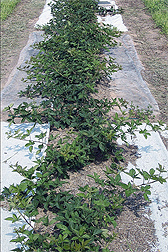This page has been archived and is being provided for reference purposes only. The page is no longer being updated, and therefore, links on the page may be invalid.
| Read the magazine story to find out more. |
|
|
|
|
Using Ground Covers in Organic Production
By Ann PerryAugust 30, 2011
Studies by U.S. Department of Agriculture (USDA) scientists indicate that organic farmers who need to periodically amend their soils with compost after planting can still control weeds-and hold down costs-by using fabric ground covers. This will be welcome news to organic farmers who till composted manure into their crop fields after planting.
Agricultural Research Service (ARS) soil scientist Larry Zibilske, who works at the agency's Integrated Farming and Natural Resources Research Unit in Weslaco, Texas, set out to see how these ground covers limit water penetration and affect carbon and nutrient levels in soils. ARS is USDA's chief intramural scientific research agency, and this work supports the USDA commitment to supporting sustainable agriculture.
Zibilske conducted a soil chamber study using two types of commercial ground covers: a needle-punched, double-layer fabric, and a tightly woven material made of flat polypropylene strands. He used two types of compost-poultry litter pellets or a compost mix of cattle manure and other organic materials-in the research.
Zibilske monitored the movement of nutrients from the two types of composted materials through the two types of ground covers for 30 days. Water was able to pass freely through the fabric cover, but the polypropylene cover limited the movement of water for the first two weeks. However, water was able to pass through the polypropylene cover much more easily by the end of the study, perhaps because the cover was becoming coated with organic molecules from the compost.
Zibilske found that soil microbial activity indicators were essentially the same in soils protected by fabric covers, soils protected by polypropylene covers, and control soil samples where the movement of nutrients had not been impeded by a ground cover. This similarity suggests that these ground covers did not significantly alter or limit biological activities in the soil. Links were also observed between the use of fabric covers and reduced soil levels of nitrogen and phosphorus levels.
The results from this study were published in 2010 in the International Journal of Fruit Science.

